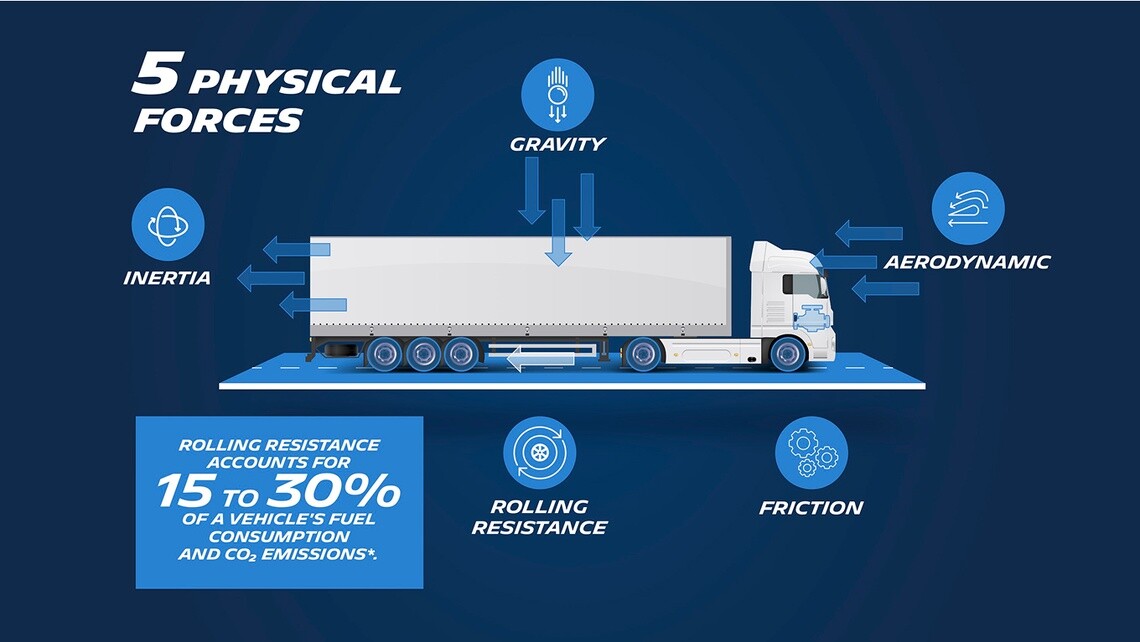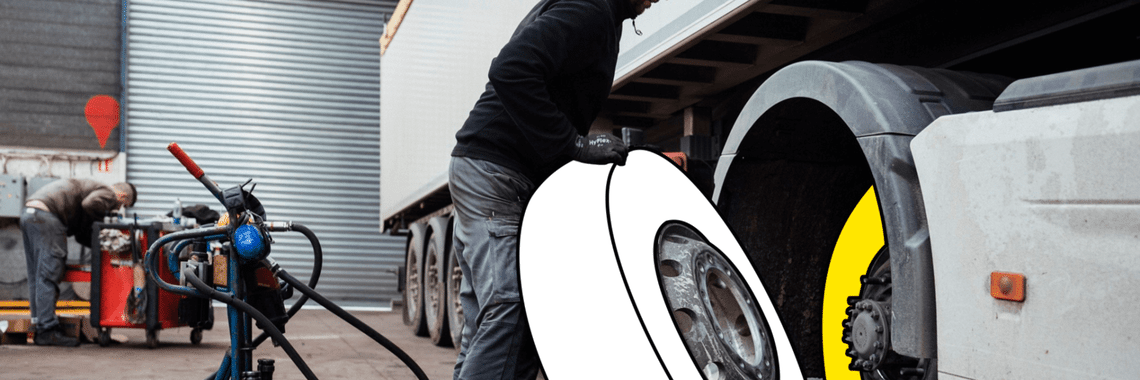
header should you focus on individual truck mpg or your entire fleet s fuel efficiency
The truck driver uses a laptop to confirm the delivery of the cargo. The concept of freight transportation. Logistics.
The traditional method of measuring your truck’s fuel use is the standard of miles per gallon (mpg). A finer approach, however, is to measure your fleet’s fuel efficiency, or gallons per mile. We sat down with Development Truck Tyre Designers at Michelin Benoît Allemand and Damien Bardin to hear their insights on the value of this approach and how an optimised tyre can improve your fleet’s overall performance.

01 benoît allemand and damien bardin gave us his insights on truck mpg measure approach
Benoît Allemand and Damien Bardin, Development Truck Tyre Designers at Michelin
Let’s start off with a reminder of truck fuel mileage, and then an explanation of truck fuel efficiency. What are the key points to keep in mind?
We’re all familiar with miles per gallon (mpg), used to see how far we go on a gallon of diesel. For a typical truck, it can be anywhere from 5 mpg to 14 mpg, depending on the type of operation and payload.1 The higher the number, the better the performance.
Truck fuel efficiency takes the mpg figure and flips it. Instead of showing the distance driven on a gallon of fuel, it shows how much fuel you use to drive each mile. You see it more often as litres per 100 kilometres (L/100km). The overall fuel efficiency for a truck is typically around 30L/100km.2
In both cases, the numbers can be impacted by road congestion, hills, weather, load and other factors.
What does truck fuel efficiency tell you that truck mileage doesn’t?
Truck fuel efficiency is a more explicit measurement. Measuring the fuel efficiency of a single truck is less meaningful on its own, but when applied to an entire fleet, it provides a clearer picture of overall fuel consumption. Since fuel is one of your key costs, knowing your truck fuel efficiency and what impacts it can help you bring fuel costs down.
How exactly do tyres impact truck fuel efficiency?
Tyres are what get and keep a truck moving. The harder it is to move the truck, the more fuel is needed. For tyres, this is measured using rolling resistance. All tyres come with a rolling resistance indicator, which is a European standard and shows a grade from A to E, like the energy rating for household appliances such as fridges and dishwashers. The better the grade, the lower the tyre rolling resistance and the more fuel efficient your trucks are. Rolling resistance is therefore an accessible, objective and robust guideline that everyone can understand.

how exactly do tyres impact truck fuel efficiency
*Internal calculation presented at the 17th International Symposium on Heavy Vehicle Transport & Technology: Australia 2023, results available here: https://hvttforum.org/wp-content/uploads/2023/12/HVTT17_paper_0454_Domprobst.pdf
What does a tyre need to have to ensure a lower rolling resistance?
There are three components to making a tyre: the casing, the tread and the best balance in overall performance. Ideally, a casing is sturdy and durable for a long service life. For the tread, the materials chosen, the tread design and its thickness all affect rolling resistance. Engineers play with all of these variables to create the tyres that will meet market demands for specific uses, optimising overall performance for the use in question. For a truck tyre that improves fuel efficiency, engineers find the ideal balance between tread thickness and wear.
And what does Michelin offer to boost rolling resistance for fleets?
The new generation of MICHELIN X® LINE ENERGYTM 3 tyres are the first 60 series fitments on the market with an A rating for rolling resistance. We combined Infinicoil and Duracoil technologies for the casing. A continuous steel wire wrapped around the tyre’s circumference and a strengthened tyre-wheel interface make the casing highly resistant to long hours on the road.

03 michelin x line energytm 3 are low rolling resistance tyres for trucks
Can you tell us about the tread on MICHELIN X® LINE ENERGYTM 3?
We included Silicion technology, which has a higher fraction of silica in the rubber compound. This helps make trucks fuel efficient and maintains tyre longevity. The Regenion technology preserves grip and safety on the road throughout the tyre’s life. Grooves and sipes renew themselves as the rubber compound wears down. There is no warping or deformation in the tyre, so no surprises for the driver, and stable fuel use throughout. Once it reaches the legal wear limit, the casing is strong enough to have several lives via regrooving and retreading. Fleet managers therefore save on both fuel and tyre costs.
Let’s dive deeper into MICHELIN X® LINE ENERGYTM 3. What are some of the key highlights?
Yes! With this latest generation, fleets can continue to reduce their TCO (total cost of ownership) while improving their environmental footprint.
Diving into the specifics, this range improves truck fuel efficiency resulting in a high fuel savings of 0.5L/100km3
With high retreadability, fleets can extend their trucks’ tyre life during the period when the tyre uses the least amount of fuel. And retreading also saves 50kg, or 70%, in raw materials per tyre on average4. Your costs are lower, and there is less waste.
The MICHELIN X® LINE ENERGY™ 3 range of fuel-saving tyres is designed for low rolling resistance to help save you money on fuel consumption. These tyres also have a regular wear pattern, allowing them to be driven down to the last millimetre.
In total for a fleet, on average you can save €872 per truck per year5.
And how does this tyre range compare when it comes to truck fuel efficiency?
The MICHELIN X® LINE ENERGYTM 3 range has been designed for heavy goods vehicles, trailers, rigid trucks and coaches that spend long hours on the road.
Today, Michelin offers two different types of low rolling resistance tyres for trucks. The MICHELIN X® LINE ENERGY™ and MICHELIN X® MULTI ENERGY™ ranges make the products accessible to more fleets, in more applications, than ever before.
So overall Michelin optimises tyre performance to ensure the right balance?
Exactly. Michelin’s entire range provides optimum capability when it comes to balancing truck fuel efficiency and truck tyre performance. This ensures fleet operations are sustainable both in terms of tyre use and cost management.
FREQUENTLY ASKED QUESTIONS
The current record for a 44-tonne articulated truck, comprising a 6x2 tractor unit and a tri-axle curtainside trailer, running around the Commercial Motor Scottish road test route (a representative long-haul test of 477 miles) is 9.82mpg. This was set in 2022 with a Volvo FH 460 with I-Save riding on a full set of tyres from the MICHELIN X® LINE ENERGY™range.6
Two main factors can help boost fuel efficiency: driver behaviour and truck tyres. Driver behaviour impacts truck fuel efficiency, through acceleration and braking. As for truck tyres, rolling resistance plays a major role. Lower rolling resistance requires less fuel, leading to better fuel efficiency. Truck tyres are rated A to E according to EU standards. Fleet managers therefore have a simple, robust and objective way of comparing tyres and understanding which tyres will improve their fleet’s fuel efficiency.
3. Michelin
https://cxf-prod.azureedge.net/b2b-experience-production/attachments/clx4tm44z007u01moxkqsk1gd-michelin-x-line-energy-z3-d3-en.pdf (1) Fuel savings & CO2 emissions based on TCO2 tool calculation hypothesis: 1 life analysis 4x2 truck & semi-trailer 3 axles, usage 100% long haul 100,000 km/year, fully loaded €1.7/litre diesel RR decreased at 70% end of 1st life.
4. Michelin
https://business.michelin.co.uk/tyres/retreading-service
5. Michelin
https://business.michelin.co.uk/tyres/michelin-x-line-energy-z3-d3-22-5
6. MC Group
https://mcgroupltd.co.uk/news/volvo-fh-460-i-save-breaks-its-own-record/

gettyimages 930571046
car going fast on a road by night







